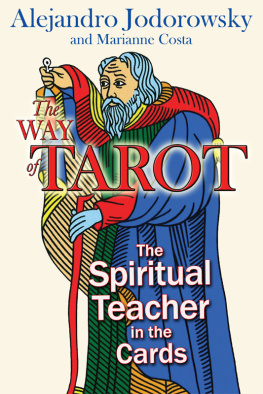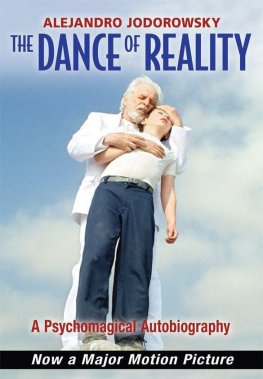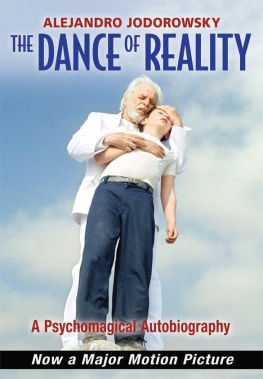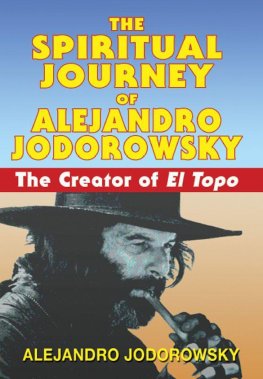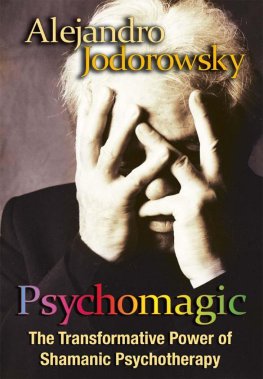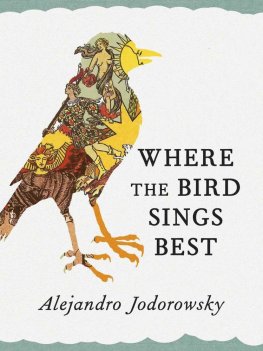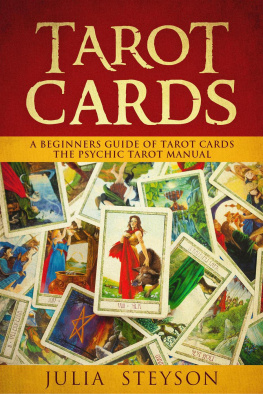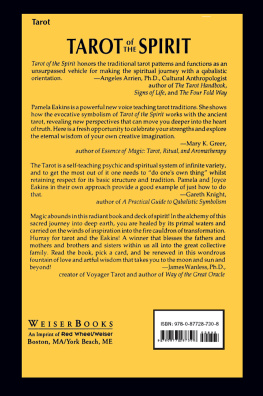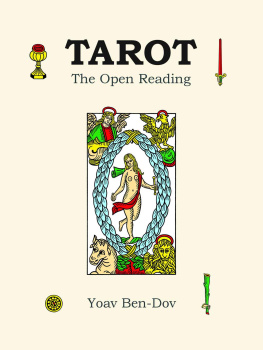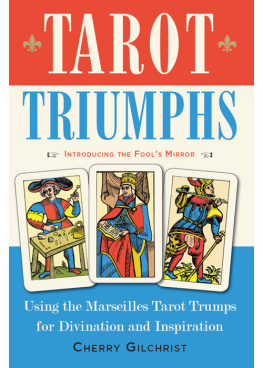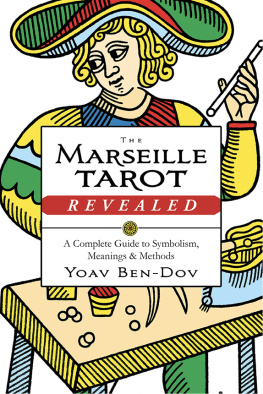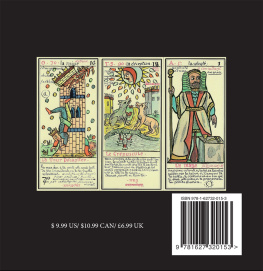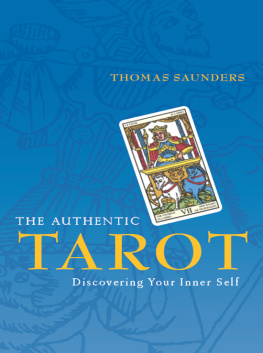The WAY of TAROT
The Spiritual Teacher in the Cards
Alejandro Jodorowsky
and Marianne Costa
Translated by Jon E. Graham

Destiny Books
Rochester, Vermont Toronto, Canada
Preface
How does one write a book about the Tarot? It is like trying to empty the sea with a fork.
For more than forty years, Alejandro Jodorowsky has been investigating the dynamic and multiple aspects of the Tarot through readings, lessons, discoveries, conferences If it had been necessary to transcribe this work in its entirety, we would have ended up with tens of thousands of pageseach equally impassioned and disorganized, each touching on the various aspects of this art that refuses to let itself be imprisoned within any kind of rigid structure.
As this was not possible and we needed one book, and only one book, Alejandro and I chose to present the Tarot from a variety of different perspectives that would allow this book to serve both as a manual for beginners and a serious tool for experienced Tarot readers, while giving all its readers a work that would be a pleasure to read.
This is why all the parts of this book include an introduction written in the first person by Alejandro, retracing the unique path he has carved out over a lifetime in the company of this demanding teacher and powerful ally known as the Tarot.
With respect to all the technical parts, our chief concern was to be faithful to the extreme plasticity of the Tarot, which is light and profound, linear and multidimensional, gamelike and complex. It refuses to be reduced to any one of the countless possibilities it opens. This is why we sought to create a book that could be read either in sections or straight through, in which each subject is both summed up briefly and discussed in great depth, and whose illustrations provide a ceaseless echo to the text, based on the truth that the Tarot constitutes first and foremost an apprenticeship in seeing.
The book has been organized into five parts. The purpose of the first part is to familiarize the reader with the overall structure of the Tarot and its numerological and symbolic foundations. The second part examines each card of the Major Arcana, while the third does the same for the Minor Arcana. The fourth part represents what we intend to be a first step in the dynamic reading of the Tarot: the study of pairs, the various combinations between two and more cards. For all intents and purposes, every element of the Tarot is linked in this fashion to all the others. Finally, the fifth part is dedicated to the actual art of reading the cards.
We want to take this opportunity to thank Barbara Clerc in particular, who has been transcribing and archiving the unpaid lessons and readings given by Alejandro Jodorowsky. She put all these archives at our disposal. Without her, they would have remained only part of oral tradition.
MARIANNE COSTA
Note: The cards reproduced in this book are taken from the Tarot of Marseille restored by Alejandro Jodorowsky and Philippe Camoin, and reproduced here with the generous permission of Camoin ditions (). Copyright 1997. All rights reserved.
Introduction
I first met the cards when I was seven years old living in Tocopilla, a small Chilean port town nestled between the glacial Pacific Ocean and the mountainous plateaus of Tarapaca, the driest region on Earth, where not a drop of rain has fallen in centuries. The town merchants would close up shop at noon until five every afternoon because of the extreme heat. My father, Jaime, would lower the metal shutter of his Casa Ukrania [Ukraine House]which sold feminine undergarments and household itemsand go play billiards at Crazy Abrahams, a Lithuanian Jewish widower who had washed up here under mysterious circumstances. In this warehouse where women never set foot, the normally competing merchants declared a momentary truce and gathered around a green table where they showed off their virility by making cannon shots. According to Jaimes philosophy a childs brain was already formed by age seven, and should be treated as an adult. So on my seventh birthday he allowed me to go with him to play billiards. The deafening noise made by the balls striking each other and the white and red trails they left across the olive-green felt failed to impress me. What did catch my eye and fascinated me was a card castle. Crazy Abraham was obsessed with building large castles out of cards. He would leave these huge and imposing constructions, no two of which were ever alike, on the bar counter far from any drafts until he got drunk and intentionally knocked them down, only to immediately begin building another. Jaime would mockingly tell me to ask the loony why he did this. Smiling sadly, he would give a child the answer he did not wish to give to adults: I am imitating God, little one, the one who creates us, destroys us, and with whats left of us, he rebuilds.
As an antidote to the boredom of provincial life, my father would invite a group of friends over to play cards for hours on Saturday evenings and Sundays after lunch while my mother, Sara Felicidad, the only woman present, served beer and canaps, like a shadow. The rest of the week the cards slept under lock and key imprisoned in a dresser. These decks fascinated me, but I was forbidden to touch them. According to my parents, they were only for adults. This gave me the idea that cards, wild beasts that could be tamed only by a wise manJaime in this instancehad magical powers As the players used beans instead of chips, every Monday my mother, perhaps to release the pain she felt at being excluded from the game, boiled them for soup, which I would slurp down with the feeling that it was giving me some of their powers.
Being the son of Russian immigrants, my physical appearance was quite different from that of the native Chileans and left me without any friends. My parents were wrapped up for ten hours a day in the Casa Ukrania and had no time for me. Weighted down by the silence and solitude, I began examining the furniture in their room in hopes of finding a detail that would would reveal the faces hidden behind their masks of indifference. In a corner of the closet, between the perfumed clothes of Sara Felicidad, I found a small rectangular metal box. My heart began beating faster. Something told me I was about to receive an important revelation. I opened it. Residing inside was a Tarot card called The Chariot. It showed a prince driving a flaming vehicle. Tongues of fire had been added with lines of black ink and colored with yellow and red watercolors. Who had gone to the trouble to transform the original drawing by adding flames? Lost in my thoughts, I did not hear my mother coming in. Caught in the act, I confessed my guilt and handed her the card. She took it from me reverently, clutched it to her chest and broke out sobbing. When she recovered her calm, she told me how her late father had always carried this card in a pocket of his shirt, close to his heart. He had once been a Russian ballet dancer who was over six feet tall and had a leonine mane of blond hair. He fell in love with my Jewish grandmother and followed her into exile, although under no obligation to do so. In Argentina, clumsy as he was in everything concerning the details of everyday life, he climbed on top of a barrel full of alcohol to try to adjust the flame of a lamp. The cover of the container gave way, and he fell into the alcohol, still holding the oil lamp in his hands. The liquid burst into flames, and my grandfather was burned alive. Sara Felicidad was born one month after this atrocious death. One day, her mother, Jasche, told her how she had found the card, intact, among the ashes of her beloved husband. One night after the burial, the flames of The Chariot appeared without anyone having drawn them. My mother harbored no doubt about the veracity of this story. In my own childish innocence, I believed it too.
Next page
